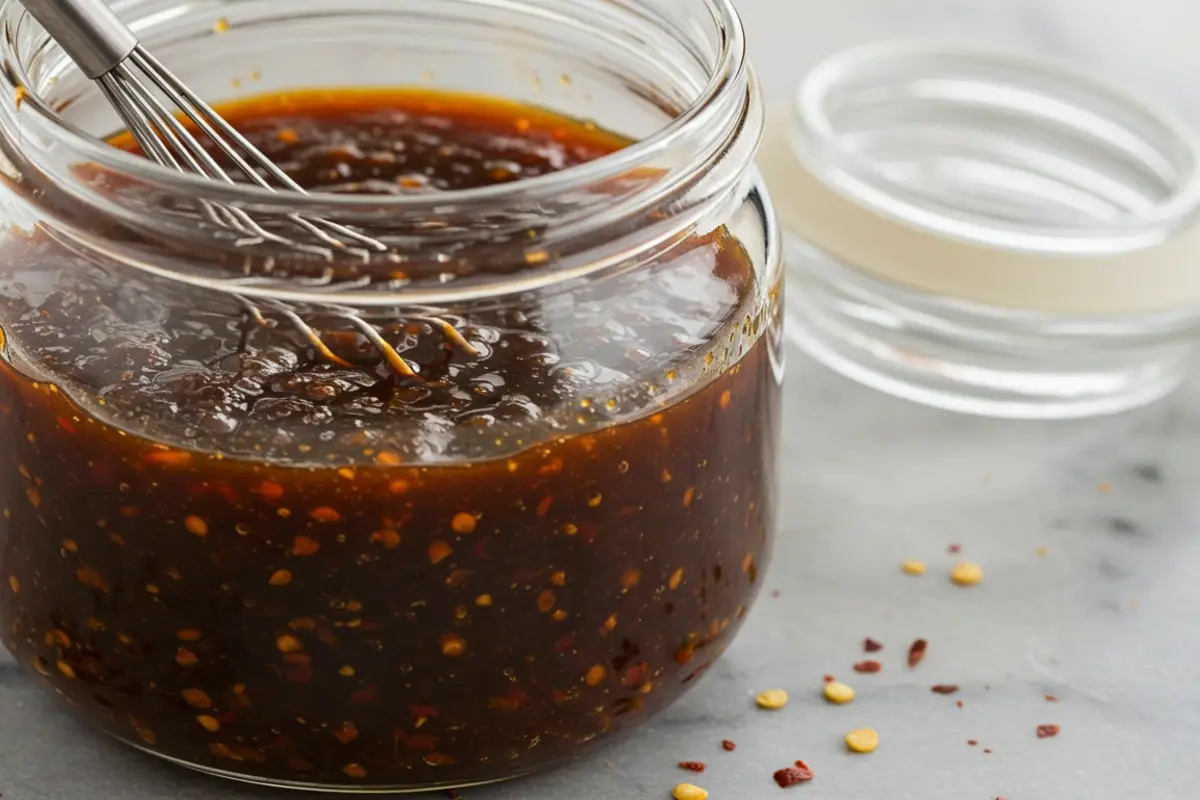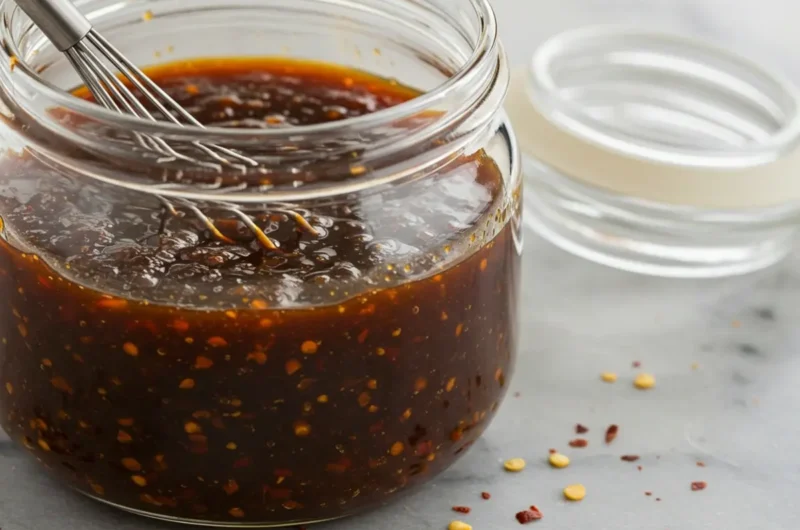Sichuan Peppercorn Sauce: The Ultimate Guide
Sichuan peppercorn sauce is a beloved staple in Asian cuisine, particularly in the Sichuan region of China. Known for its bold and distinctive flavor profile, this sauce is a key element in many dishes, offering a unique combination of heat and numbing sensation, a characteristic feature of Sichuan peppercorns. These peppercorns are not true pepper, but the dried husks of the prickly ash tree, and they contain a compound called hydroxy-alpha-sanshool, which creates the “numbing” effect on the tongue.
What sets Sichuan peppercorn sauce apart from other sauces is its remarkable balance between spice, tanginess, and a subtle floral note, which complements savory dishes with an unforgettable taste. The Sichuan peppercorns used in the sauce add an aromatic and zesty kick that sets it apart from traditional pepper-based sauces. This sauce is widely used in stir-fries, braised meats, and noodle dishes, and it has grown in popularity beyond China, becoming a sensation in global culinary scenes.
Whether used in home cooking or fine dining, Sichuan peppercorn sauce is a versatile and flavorful addition to any kitchen, making it an essential element in exploring the complexities of Sichuan cuisine
Table of Contents
What is Sichuan Peppercorn Sauce?
Sichuan peppercorn sauce is a flavorful and aromatic sauce that is a hallmark of Sichuan cuisine, a well-known culinary tradition from the Sichuan province in southwestern China. This sauce is crafted using the unique Sichuan peppercorns, which give it a distinctive taste that combines both numbing (known as má) and spicy (là) elements, creating a one-of-a-kind flavor experience.
Definition and History of Sichuan Peppercorn Sauce
Sichuan peppercorn sauce is typically made by infusing Sichuan peppercorns with other ingredients like garlic, ginger, soy sauce, vinegar, and sometimes sugar, to create a balance of savory, spicy, and tangy notes. The sauce is a vital component in many Sichuan dishes, where it adds depth, complexity, and a signature mouthfeel. Traditionally, it is used in stir-fries, hotpots, braised meats, and noodle dishes, but its versatility has allowed it to be incorporated into various other cuisines.
Historically, Sichuan peppercorns have been a key part of Sichuan cooking for centuries. The sauce itself likely evolved over time as a way to highlight the peppercorn’s distinctive numbing sensation and to balance the region’s love for spicy food. The infusion of peppercorns into sauces helped elevate the flavor profiles of many Sichuan dishes, and it has now become a globally recognized condiment, often used to add an exotic twist to everyday meals.
How Sichuan Peppercorns Contribute to the Distinctive Flavor of the Sauce
The Sichuan peppercorns used in the sauce are responsible for the unique sensory experience that sets it apart from other sauces. Unlike regular black pepper, Sichuan peppercorns don’t provide a burning heat but instead create a tingling, numbing sensation on the tongue. This numbing effect, known as má, works harmoniously with the heat from other ingredients like chili peppers (là), creating a delightful contrast. The peppercorns have a slightly citrusy, floral, and earthy flavor that is pungent yet fragrant, which adds complexity to the sauce and enhances the other ingredients.
When Sichuan peppercorns are used in the sauce, their unique combination of flavors and numbing sensation elevates the dish, providing a mouthwatering balance of spicy, tangy, and savory notes. This makes Sichuan peppercorn sauce not just a condiment, but an essential element that defines many classic Sichuan dishes.
Jump to RecipeMain Ingredients of Sichuan Peppercorn Sauce
The essential ingredients of Sichuan peppercorn sauce combine to create a bold, balanced flavor. Here’s how each contributes:
1. Sichuan Peppercorns
The key ingredient, Sichuan peppercorns, provide the signature numbing sensation and a unique citrusy, floral flavor. They are essential for the distinct taste of the sauce.
2. Soy Sauce
Soy sauce adds a rich umami and saltiness, balancing the numbing effect of the Sichuan peppercorns and complementing the heat from other ingredients.
3. Garlic
Garlic gives the sauce a savory, aromatic depth. Its pungency enhances the overall flavor and adds warmth when sautéed.
4. Ginger
Ginger adds a zesty kick and helps balance the heat, while its subtle sweetness enriches the sauce.
5. Vinegar
Vinegar, usually rice or black vinegar, provides acidity, cutting through the richness and balancing the sauce’s flavors with a tangy brightness.
6. Sugar (Optional)
A touch of sugar can add sweetness to balance the tanginess and heat, creating a more harmonious flavor profile.
7. Chili Peppers (Optional)
Chili peppers add additional heat, complementing the Sichuan peppercorns to enhance the sauce’s fiery spiciness.
How to Make Sichuan Peppercorn Sauce
Making Sichuan peppercorn sauce at home is easy and brings the authentic taste of Sichuan cuisine to your dishes. Follow these simple steps to create your own flavorful sauce!
Step-by-Step Instructions:
Toast the Sichuan Peppercorns
Start by toasting the Sichuan peppercorns in a dry pan over medium heat for 2-3 minutes. The heat will bring out their fragrant oils and unique aroma, which is the foundation of the sauce.

Grind the Peppercorns
Once toasted, grind the peppercorns into a fine powder using a mortar and pestle or spice grinder. This releases their numbing compound, essential for the distinct flavor.
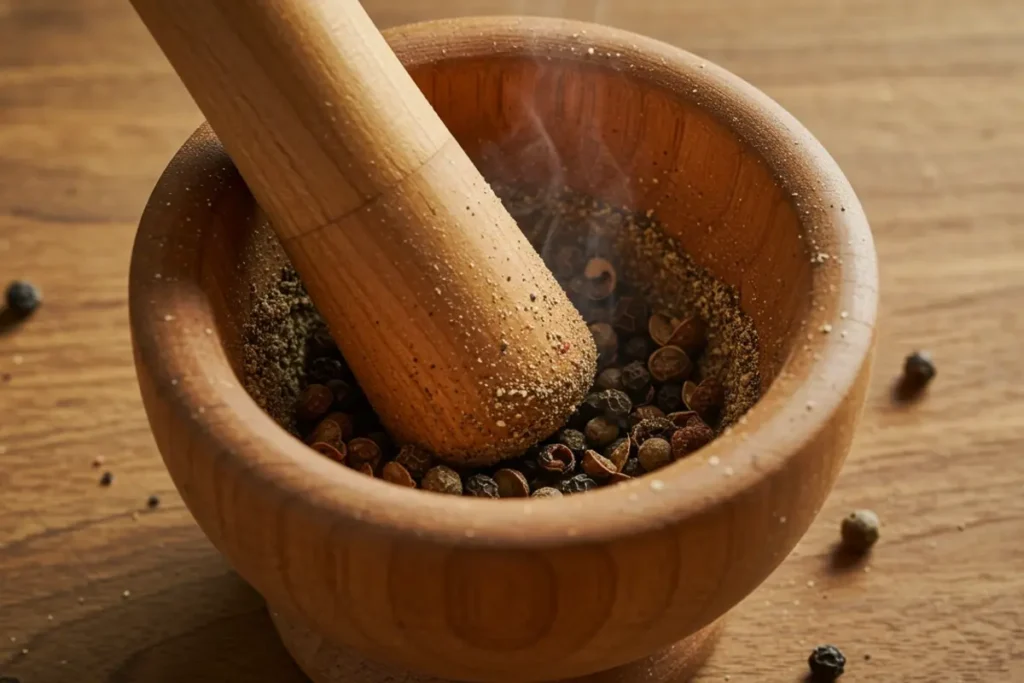
Sauté Garlic and Ginger
Heat 2 tablespoons of oil in a pan. Add finely chopped garlic and ginger, and sauté for 1-2 minutes until they become fragrant. These aromatics enhance the sauce’s richness.
Add Soy Sauce and Vinegar
Stir in 1/4 cup of soy sauce and 1-2 tablespoons of vinegar (preferably rice vinegar for a milder taste). This combination forms the sauce’s savory and tangy base.
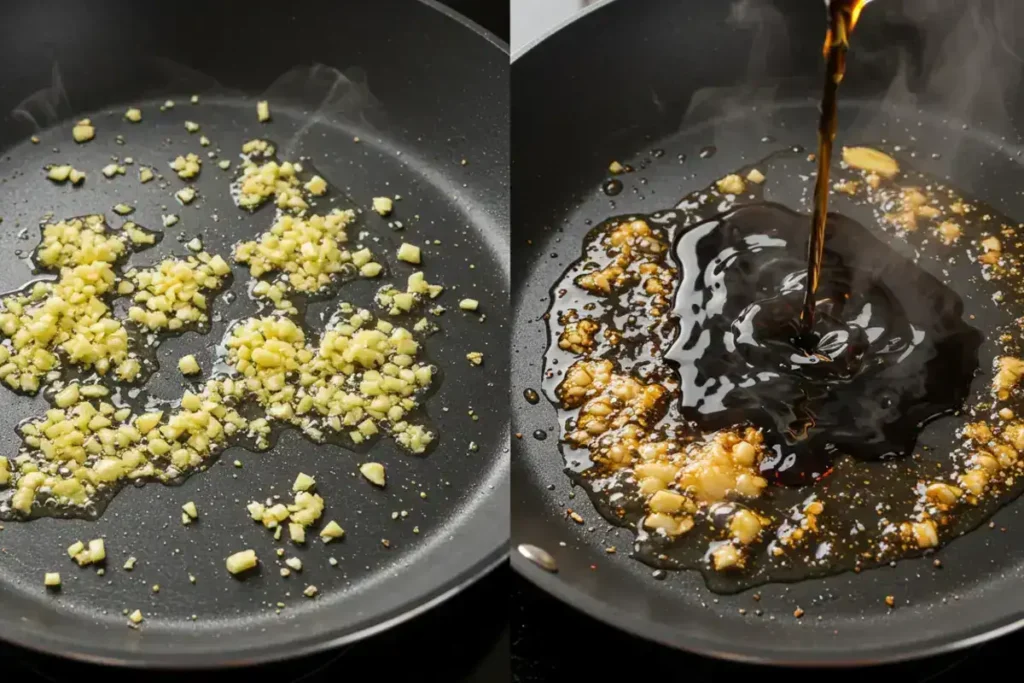
Incorporate Ground Peppercorns
Add the freshly ground Sichuan peppercorns into the pan, stirring well to blend the flavors. Let the mixture cook for a couple of minutes to allow the flavors to marry.
Balance with Sweetness (Optional)
For a touch of sweetness, dissolve 1-2 teaspoons of sugar into the sauce. This balances the heat and acidity, creating a smooth finish.
Adjust the Heat
Depending on your preference for spiciness, add chili paste or crushed dried chili peppers to intensify the heat. More Sichuan peppercorns will increase the numbing sensation if desired.
Simmer and Serve
Let the sauce simmer for a few more minutes to thicken and develop a richer flavor. Taste and adjust the seasoning if needed, and your Sichuan peppercorn sauce is ready to be served!

Recipe Variations:
- Milder Heat: Use fewer Sichuan peppercorns and skip the chili peppers for a more subtle sauce.
- Extra Spice: Increase the chili paste or add fresh chili slices for a fiery kick.
- Sweet and Tangy: For a more balanced flavor, add extra sugar or a splash of honey, giving the sauce a sweet and sour profile.
- Vegan-Friendly: Substitute tamari for soy sauce to keep it gluten-free and vegan.
Variations of Sichuan Peppercorn Sauce
While Sichuan peppercorns are the key ingredient in this sauce, there are a few variations you can try, especially if you can’t find them or want to customize the flavor to your preference. Here are some suggestions:
Substitutions for Sichuan Peppercorns
- Chinese Five-Spice Powder
If Sichuan peppercorns are unavailable, you can use Chinese five-spice powder, which includes star anise, cloves, Chinese cinnamon, fennel seeds, and peppercorns. While it won’t replicate the numbing sensation, it adds a similar aromatic and spicy depth. - Lemon Zest & Black Peppercorns
For a more accessible substitute, mix lemon zest (for the citrusy, floral notes) and black peppercorns (for heat) in equal parts. This won’t provide the numbing sensation, but it brings a bright and spicy flavor. - Pink Peppercorns
Pink peppercorns have a mild, fruity flavor that’s not as intense as Sichuan peppercorns, but it can mimic the floral aspect while adding a peppery bite. - Coriander Seeds & Lemon
You can use ground coriander seeds with a splash of lemon juice to get a similar citrusy and earthy flavor. This substitute won’t create the numbing sensation but can still offer a pleasant depth.
Personalizing the Recipe Based on Taste Preferences
- Adjusting the Spice Level
- Mild: If you prefer a mild flavor, reduce the amount of Sichuan peppercorns or opt for fewer chili peppers. A small pinch of sugar can also help balance the heat.
- Spicy: To increase the heat, add more Sichuan peppercorns, or include extra dried chili flakes or chili paste. Fresh chili slices can also intensify the heat.
- Sweet & Tangy Twist
For a more complex flavor, add a little honey or brown sugar for sweetness, and increase the vinegar slightly for a tangier finish. This creates a sweet-sour balance that pairs wonderfully with spicy dishes. - Umami Boost
You can add a tablespoon of miso paste or a dash of fish sauce to deepen the umami flavor of the sauce. This adds richness, especially for more savory or meaty dishes. - Herb Infusion
Fresh herbs like basil, cilantro, or mint can be added at the end for a fresh, fragrant twist, especially in stir-fries or noodle dishes.
Final Thoughts
Feel free to adjust the ingredients based on your taste preferences or what you have on hand. Whether you like it milder, sweeter, or spicier, Sichuan peppercorn sauce can be personalized to suit any palate.
Uses of Sichuan Peppercorn Sauce
Sichuan peppercorn sauce is incredibly versatile and can be used in a wide variety of dishes. Its unique flavor, combining numbing heat and aromatic spices, makes it an excellent complement to many types of food. Here are some popular dishes that pair beautifully with this sauce:
Popular Dishes to Pair with Sichuan Peppercorn Sauce
- Meat Dishes
- Sichuan Peppercorn Chicken: Toss crispy fried chicken with the sauce for a perfect combination of heat and numbing spice.
- Szechuan Beef Stir-fry: Thin slices of beef stir-fried with bell peppers, onions, and the sauce for a hearty, flavorful dish.
- Kung Pao Shrimp: A quick stir-fry of shrimp, peanuts, and vegetables with a generous drizzle of Sichuan peppercorn sauce.
- Tofu Dishes
- Sichuan Mapo Tofu: Silken tofu in a spicy, numbing sauce made with Sichuan peppercorns, ground pork, and fermented beans.
- Spicy Tofu Stir-fry: Pan-fried tofu cubes tossed with Sichuan peppercorn sauce, vegetables, and a dash of soy sauce.
- Vegetable Dishes
- Sichuan Stir-fried Asparagus: Asparagus stir-fried with garlic, ginger, and Sichuan peppercorn sauce for a flavorful, savory side.
- Sichuan Eggplant: Tender eggplant pieces simmered in the sauce for a deeply flavorful, spicy vegetable dish.
- Noodles & Rice Dishes
- Dan Dan Noodles: Noodles dressed in a spicy, savory sauce made with Sichuan peppercorns, chili paste, and ground pork.
- Sichuan Fried Rice: Add a spoonful of Sichuan peppercorn sauce to fried rice for a spicy kick.
- Hot Pot
Use Sichuan peppercorn sauce as a dipping sauce or as a base for the broth in a hot pot. The numbing effect will enhance the flavor of meats, tofu, and vegetables as they cook in the broth.
Tips for Incorporating Sichuan Peppercorn Sauce into Various Asian Cuisines
- Chinese Cuisine
- Stir-fries: Incorporate Sichuan peppercorn sauce into stir-fries for a bold and spicy flavor, particularly with meat, tofu, and vegetables.
- Dim Sum: Use the sauce as a dipping sauce for dumplings or buns, adding a numbing heat to complement the savory fillings.
- Thai Cuisine
- Thai Noodles: Add the sauce to Thai noodle dishes like Pad Thai or Pad See Ew for an unexpected spicy, numbing twist.
- Curries: Stir a little Sichuan peppercorn sauce into Thai curries for extra depth and complexity.
- Japanese Cuisine
- Ramen: Use the sauce in a ramen broth to enhance the flavor with numbing, spicy notes that pair wonderfully with the noodles and toppings.
- Tempura: Serve the sauce as a dipping sauce for crispy tempura vegetables and shrimp to add heat and flavor.
- Korean Cuisine
- Korean BBQ: Serve Sichuan peppercorn sauce as a dipping sauce alongside grilled meats like bulgogi or galbi, or add it to the marinade for an exciting twist.
- Kimchi Stir-fry: Use the sauce in kimchi stir-fries for a fiery, tangy flavor that enhances the dish.
- Fusion Dishes
- Sichuan Peppercorn Pizza: Add a drizzle of the sauce over a pizza with spicy sausage or vegetables for an Asian fusion twist.
- Sichuan Peppercorn Wings: Toss crispy chicken wings in the sauce for a perfect fusion of heat, numbing spice, and savory goodness.
Sichuan peppercorn sauce is a versatile, bold condiment that can enhance a wide variety of dishes across Asian cuisines. Whether you’re pairing it with meat, tofu, or vegetables, this sauce adds depth, flavor, and a signature numbing heat. It’s perfect for stir-fries, noodles, rice dishes, and even as a dipping sauce for appetizers. Use it to bring an authentic Sichuan flavor to your favorite meals!
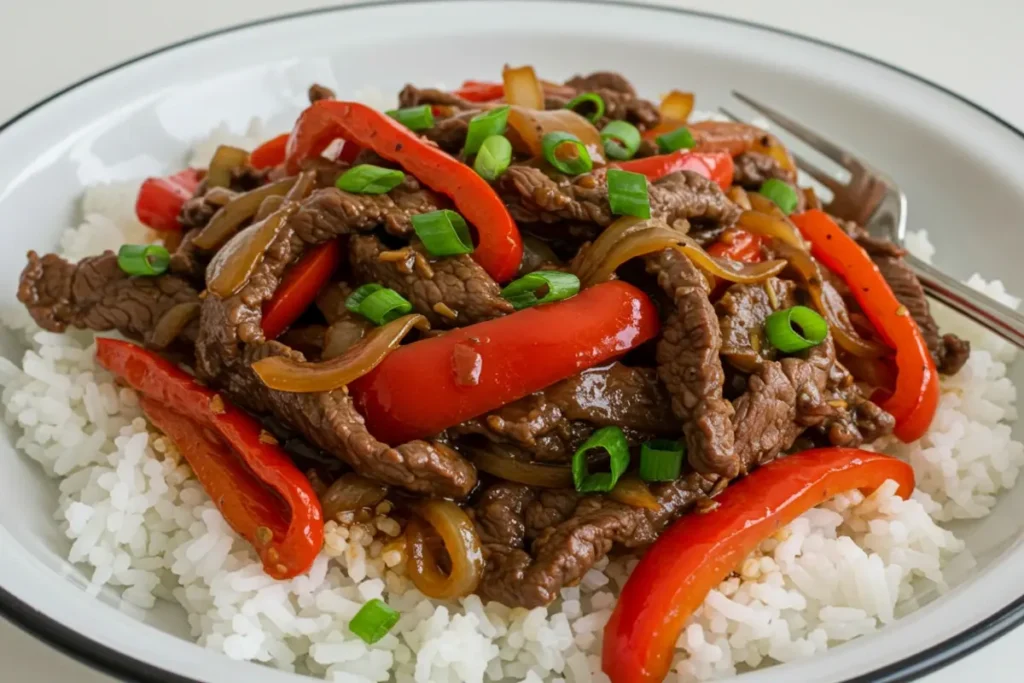
FAQS
Are Sichuan peppercorns spicy?
Sichuan peppercorns aren’t hot like regular peppers; they create a unique numbing sensation in the mouth instead. Instead of heat, they produce a unique tingling or numbing sensation in the mouth, known as “má” in Sichuan cuisine. This effect is caused by a compound called hydroxy-alpha-sanshool.
Is Sichuan sauce spicy?
The spiciness of Sichuan sauce depends on the ingredients used. While Sichuan peppercorns provide a numbing sensation, chili peppers or chili paste contribute the heat. You can adjust the spiciness by varying the amount of chili used.
How do you make Gordon Ramsay peppercorn sauce?
Gordon Ramsay’s peppercorn sauce is a classic French-style sauce made with black peppercorns, cream, stock, and brandy. Unlike Sichuan peppercorn sauce, it’s rich and creamy, with a strong focus on the flavor of black pepper.
How can I substitute Sichuan peppercorn?
If you can’t find Sichuan peppercorns, you can use alternatives like pink peppercorns or a mix of black peppercorns with citrus zest (lemon or orange) for a similar flavor profile. However, they won’t replicate the numbing sensation.
What is the closest thing to Sichuan pepper?
The closest alternatives to Sichuan peppercorns are pink peppercorns or Japanese sansho pepper, which offer a mild citrusy flavor but lack the intense numbing effect. Lemon zest combined with pepper can also be a substitute.
Is Sichuan peppercorn the same as black peppercorn?
No, Sichuan peppercorns and black peppercorns are very different. Black peppercorns are spicy and pungent, while Sichuan peppercorns provide a numbing, citrusy flavor with no heat. They belong to different plant families and offer distinct sensory experiences.
Storage and Shelf Life Tips
- Sichuan peppercorn sauce can be stored in an airtight container in the fridge for up to 1-2 weeks.
- Sichuan peppercorns should be kept in a cool, dry place in an airtight container to maintain freshness for up to 6 months. For longer storage, keep them in the freezer.
Sichuan Peppercorn Sauce: The Ultimate Guide
Course: Classic u0026amp; Signature SaucesCuisine: American, ChineseDifficulty: Easy4
servings10
minutes5
minutes98
kcal15
minutesThis Szechuan sauce is a delightful blend of sweet and spicy flavors, perfect for adding a punch to stir-fries, and noodles, as a dipping sauce, or even as a marinade. It’s quick to prepare and will elevate your meals with minimal effort.
Ingredients
1/4 cup soy sauce
2 tablespoons rice vinegar
1 tablespoon sesame oil
1 tablespoon brown sugar or honey
1 tablespoon chili garlic sauce
1/2 tablespoon ground ginger (fresh minced ginger works well too)
1 teaspoon garlic powder (or fresh minced garlic)
1/4 – 1/2 teaspoon Szechuan peppercorns, lightly toasted and ground
1 teaspoon crushed red pepper flakes
Optional Ingredients:
1/2 cup chicken stock
1-2 tablespoons cornstarch (for thickening)
1/2 – 1 teaspoon Chinese 5-spice
1 teaspoon sriracha (adjust to taste)
Directions
- Toast the Sichuan Peppercorns
Start by toasting the Sichuan peppercorns in a dry pan over medium heat for 2-3 minutes. The heat will bring out their fragrant oils and unique aroma, which is the foundation of the sauce. - Grind the Peppercorns
Once toasted, grind the peppercorns into a fine powder using a mortar and pestle or spice grinder. This releases their numbing compound, essential for the distinct flavor. - Sauté Garlic and Ginger
Heat 2 tablespoons of oil in a pan. Add finely chopped garlic and ginger, and sauté for 1-2 minutes until they become fragrant. These aromatics enhance the sauce’s richness. - Add Soy Sauce and Vinegar
Stir in 1/4 cup of soy sauce and 1-2 tablespoons of vinegar (preferably rice vinegar for a milder taste). This combination forms the sauce’s savory and tangy base. - Incorporate Ground Peppercorns
Add the freshly ground Sichuan peppercorns into the pan, stirring well to blend the flavors. Let the mixture cook for a couple of minutes to allow the flavors to marry. - Balance with Sweetness (Optional)
For a touch of sweetness, dissolve 1-2 teaspoons of sugar into the sauce. This balances the heat and acidity, creating a smooth finish.
Adjust the Heat
Depending on your preference for spiciness, add chili paste or crushed dried chili peppers to intensify the heat. More Sichuan peppercorns will increase the numbing sensation if desired.
Simmer and Serve
Let the sauce simmer for a few more minutes to thicken and develop a richer flavor. Taste and adjust the seasoning if needed, and your Sichuan peppercorn sauce is ready to be served!
Notes
- Recipe Notes for Szechuan Sauce
Adjust Spice: Reduce red pepper flakes for less heat or add more sriracha for extra spice.
Thickening: Use more cornstarch if you prefer a thicker sauce.
Storage: Keep in the fridge for up to a week. Reheat and thin with water if needed.
Versatile: Great for stir-fries, noodles, and as a marinade.
Sichuan peppercorn sauce is a flavorful and versatile addition to any dish, with its unique numbing, spicy kick. Whether you’re using it in stir-fries, noodles, or as a dipping sauce, it adds an authentic Sichuan touch to your meals. Feel free to experiment with different variations to suit your taste preferences, and enjoy the bold flavors of this unforgettable sauce!
Your delicious feedback
Simply delicious!
I tried it, and it was so delicious with salmon

